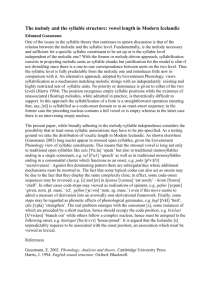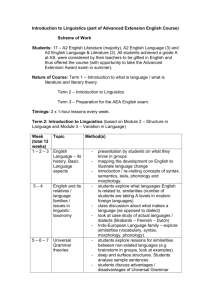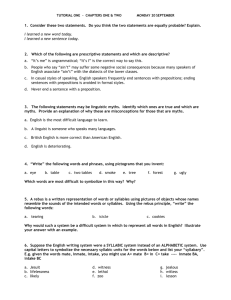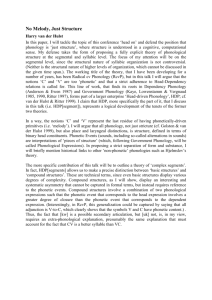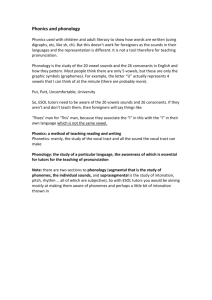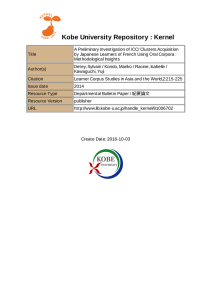doc
advertisement
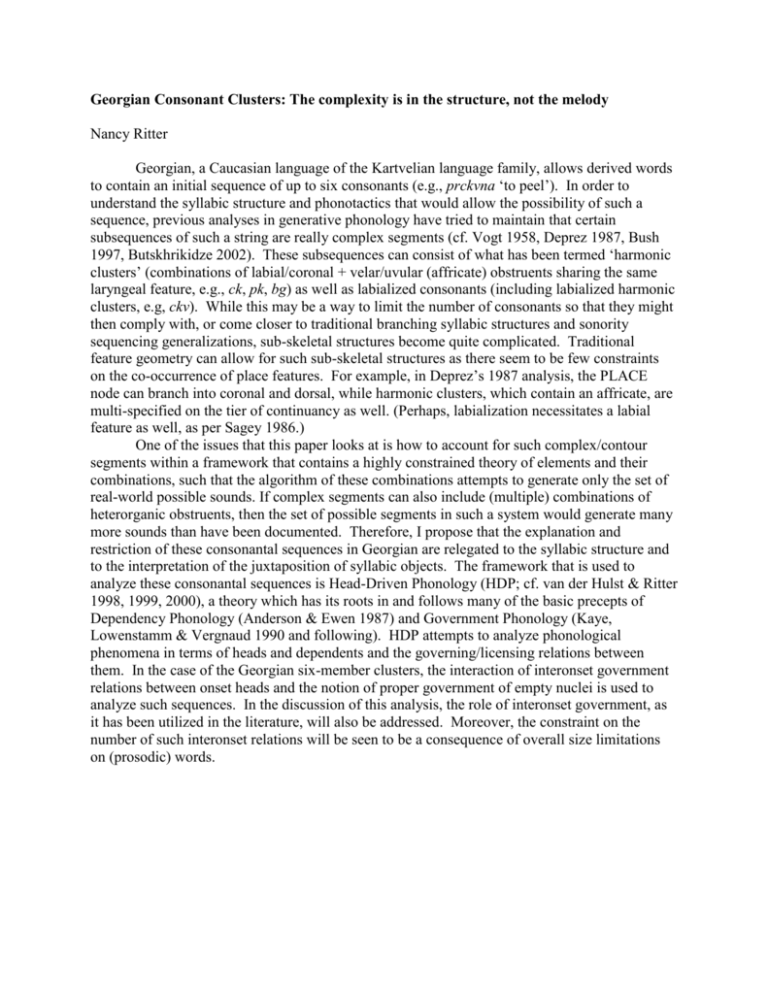
Georgian Consonant Clusters: The complexity is in the structure, not the melody Nancy Ritter Georgian, a Caucasian language of the Kartvelian language family, allows derived words to contain an initial sequence of up to six consonants (e.g., prckvna ‘to peel’). In order to understand the syllabic structure and phonotactics that would allow the possibility of such a sequence, previous analyses in generative phonology have tried to maintain that certain subsequences of such a string are really complex segments (cf. Vogt 1958, Deprez 1987, Bush 1997, Butskhrikidze 2002). These subsequences can consist of what has been termed ‘harmonic clusters’ (combinations of labial/coronal + velar/uvular (affricate) obstruents sharing the same laryngeal feature, e.g., ck, pk, bg) as well as labialized consonants (including labialized harmonic clusters, e.g, ckv). While this may be a way to limit the number of consonants so that they might then comply with, or come closer to traditional branching syllabic structures and sonority sequencing generalizations, sub-skeletal structures become quite complicated. Traditional feature geometry can allow for such sub-skeletal structures as there seem to be few constraints on the co-occurrence of place features. For example, in Deprez’s 1987 analysis, the PLACE node can branch into coronal and dorsal, while harmonic clusters, which contain an affricate, are multi-specified on the tier of continuancy as well. (Perhaps, labialization necessitates a labial feature as well, as per Sagey 1986.) One of the issues that this paper looks at is how to account for such complex/contour segments within a framework that contains a highly constrained theory of elements and their combinations, such that the algorithm of these combinations attempts to generate only the set of real-world possible sounds. If complex segments can also include (multiple) combinations of heterorganic obstruents, then the set of possible segments in such a system would generate many more sounds than have been documented. Therefore, I propose that the explanation and restriction of these consonantal sequences in Georgian are relegated to the syllabic structure and to the interpretation of the juxtaposition of syllabic objects. The framework that is used to analyze these consonantal sequences is Head-Driven Phonology (HDP; cf. van der Hulst & Ritter 1998, 1999, 2000), a theory which has its roots in and follows many of the basic precepts of Dependency Phonology (Anderson & Ewen 1987) and Government Phonology (Kaye, Lowenstamm & Vergnaud 1990 and following). HDP attempts to analyze phonological phenomena in terms of heads and dependents and the governing/licensing relations between them. In the case of the Georgian six-member clusters, the interaction of interonset government relations between onset heads and the notion of proper government of empty nuclei is used to analyze such sequences. In the discussion of this analysis, the role of interonset government, as it has been utilized in the literature, will also be addressed. Moreover, the constraint on the number of such interonset relations will be seen to be a consequence of overall size limitations on (prosodic) words. A brief overview of the analysis of /prckvna/ is given as an example: Interonset govt. ------->--------- resolution O R1 O R2 O R3 O R4 O R5 [p 0 (r) c 0 k 0 v] [n 0] [ a] coda-lic. coda-lic. - The first rhyme contains an empty nucleic head followed by a post-nucleic r ( _.A). By virtue of this empty nucleus being in a structural governing head position, it must also be contentful. In order then for this head to govern its dependent, it absorbs the coda’s elemental expression such that this construction projects to the rhymal projection as one fused object. This construction is thus resolved within the rhyme and is not subject to proper government, which operates upon the rhymal projection. Phonetically this structure yields a syllabic segment ( a segment neither totally vocalic nor totally consonantal). There are certain conditions under which this r can be optional. A discussion of these conditions and how to analyze them in this approach will be presented in the paper. - The same analysis as for the first rhyme can be given for R3. In this case, however, the language interprets syllabic v as a labialized off-glide. Sonorants sandwiched between two consonants are claimed to be syllabic by many in the literature. - The second rhyme is silent because it falls within an interonset relationship between two onset heads. This relationship is a protected environment such that no other object can intervene between the head and its dependent in this relationship and it behaves as one unit, as a branching structure would. - The fourth rhymal head is empty and merges with R5 because there is no intervening overt onset; this has been termed ‘resolution’ in the Government literature.
